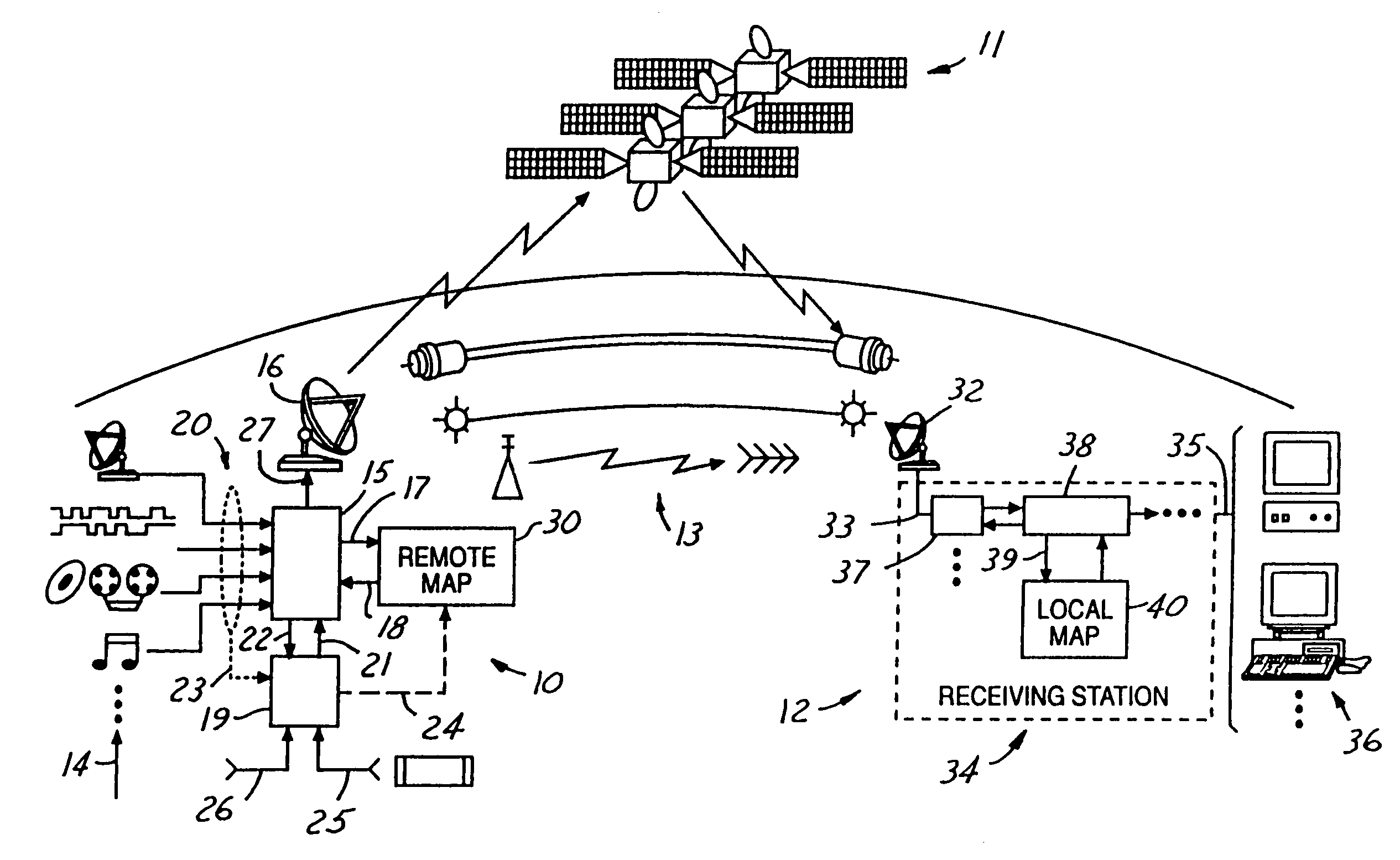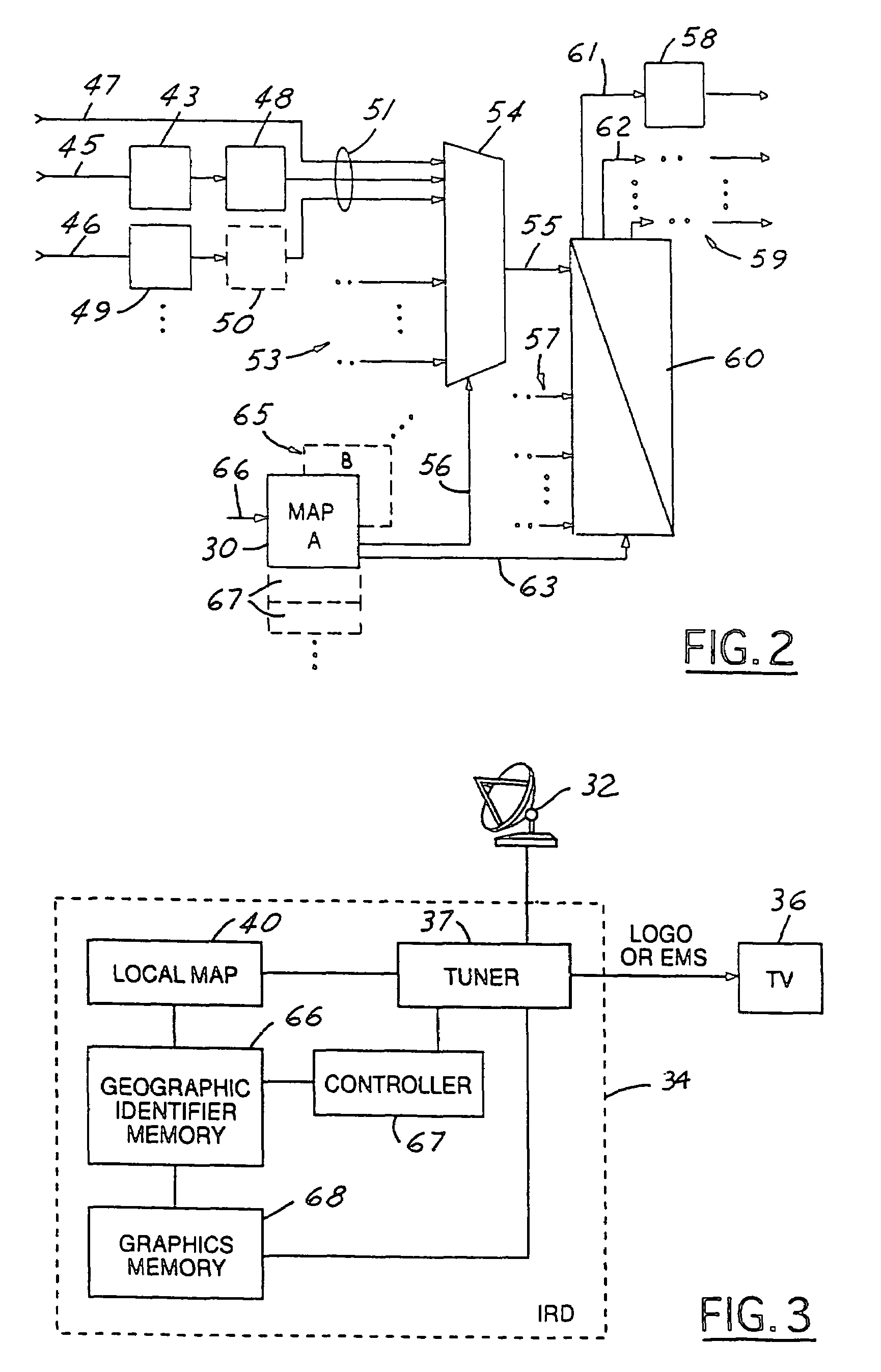[0028]In aspects of the invention, the channel mapping described is dynamically updated. It may, for example, be synchronized to frequent (e.g. real-time) changes in the desired utilization of particular broadcast resources, to accommodate dynamically changing similarity or identity between certain input data streams. By way of example, the mapping may be modified as often as required, and when required, in order to generate at least n output data streams sufficiently identical in relevant content to n input data streams, by means (at least periodically) of fewer than n broadcast resources. By dynamically adjusting the necessary mapping as required to meet such changing circumstances (i.e. as redundant programs begin and end on one or more sets of input data streams, or as non-common content such as desired commercials or source identifications occur in programs involved in n:n-y remote mapping, or as load requirements on the transmission media vary), maximum utilization of available broadcast resources can be achieved.
[0032]Transmission of the local map requires allocation of broadcast bandwidth, which can be counterproductive to the desired goal of maximizing bandwidth available for useful program transmission. This is particularly true in a fully dynamic system, which might require frequent transmission of new maps to accommodate changes in the program streams. For example, if the mapping scheme is accommodating numerous redundancies to free several broadcast resources, including some program streams which have relatively frequent requirements for remapping to a 1:1 correspondence (e.g. during desired commercials or source identifications), the transmission of map data could be a significant burden on the system. In other important aspects of the present invention, these difficulties are avoided by providing improved transmission and updating schemes for local maps. For example, in preferred embodiments the receiving apparatus which receives and stores the local map is adapted to receive updates to less than the complete map. In this manner, only the changed information, together with necessary overhead, is required for transmission when a map update is desired. In the case of a high capacity DBS system, this may result in significant bandwidth saving since the majority of programs, and therefore broadcast resources, will not be involved in dynamic re-mapping during most time slots. Therefore the majority of the local map may be relatively static (as in the prior art) while other portions can be dynamically updated in accordance with the present invention. Although the complete local map may preferably be transmitted occasionally (to permit activation of new equipment and provide a periodic
integrity check to correct any errors) such full map transmissions are reduced.
[0033]To further minimize transmission requirements for map changes, a plurality of complete maps may be transmitted and stored locally. For example, a first complete map can be transmitted and stored, followed by a second complete map stored in other memory. The receiving apparatus includes a map selector (e.g. selection vector, multiplexor, etc.) which selects the stored map that is to be active at a given time. To accomplish a change in local mapping, it is then necessary only to cause the
receiver to select the desired alternate map. More than one available map may be locally stored, and transitions between these maps may be made repeatedly. For example, one map might allocate viewer channels to the broadcast resources during normal program periods, while another map returns to 1:1 correspondence during commercials (e.g. where it is contractually required that the promotional content of an input
data stream be made identically available to viewers). Although a given program might have many commercials, each requiring two map changes, only two map transmissions would be required, followed by suitable signals to initiate the necessary local map selections. These selection signals will typically require much less
transmission bandwidth than a complete or partial map, resulting in significant
bitstream savings.
[0034]To minimize memory requirements (e.g. in a DBS IRD), the map may be divided into individual regions or segments, such as a main map and a plurality of sub-maps. The main map (which may be considered as a specialized sub-map) can contain mapping information which is common to all of a plurality of selectable maps, while other sub-maps may include those portions of the mapping which are unique to individual selectable maps. Transition from one map to another would require selection only of the appropriate sub-map, while the main map would continue to be effective. In this manner, additional transmission resources are saved since the common portion of the several local maps need only be transmitted once, and map updates, selection and transitions are facilitated.
[0036]The foregoing aspects of the present invention greatly reduce
time delays and overhead requirements when making local map changes. Reducing at least some transmissions to only those portions of a map which must be updated, or eliminating at least some repetitive or redundant map information transmissions, not only reduces the amount of bandwidth required for transmitting the
overhead information, but also reduces the time required for making the necessary
data transmission. For example, the time required to send a complete channel map in a high capacity DBS system, utilizing generally allocated transmission resources and speeds, could be two to three seconds or longer. Typically a complete map must be received accurately before the new map can be implemented, thereby restricting how quickly the system can adapt to changing requirements. Further, certain receiving equipment may impose its own hardware or
processing restrictions in activating newly delivered local maps. In other aspects of the present invention, these shortcomings are minimized or eliminated. For example, by sending only update portions of a local map (e.g. individual sub-maps), the transmission times required are significantly reduced. Further, by transmitting a plurality of alternate and / or sub-maps once, and storing them locally for later selection, subsequent transmission delays (e.g. when commercials occur during a program) are completely avoided.
[0037]To dynamically synchronize changes in the utilization of broadcast resources, the map system may include a synchronization mechanism to coordinate activation of maps. The synchronization mechanism may include a
timestamp instructing map selectors when and / or how particular map information (whether complete or partial) is to become effective. By way of example, the
timestamp may indicate immediate activation, or an absolute time (e.g. GMT) upon which the map is to become active. In aspects of the present invention, the
timestamp may also comprise an offset or
delay time after which it is to become active (e.g. two seconds after
receipt, or ten frames after a trigger event, etc.); a trigger event which will cause the map to become effective (e.g.
receipt of a command over a command
data stream or as part of the program
data stream); activation in response to action by a local user (e.g. manual selection of a local map by means of a control panel or
remote control device); or other suitable means. Where an absolute timestamp is used, all apparatus can be synchronized to switch effective maps at the same instant. This will be particularly useful where changes in the input data streams are known in advance (e.g. program changes are scheduled in advance to occur at certain known times). The use of a trigger event permits greater flexibility to accommodate unscheduled changes (e.g. early or late game starts, game completions, or time-outs during a sporting event during which commercials must be 1:1 mapped to viewer channels, etc.). Where a plurality of selectable local maps are stored in local memory, they may be switched nearly instantaneously by the local apparatus on
receipt of the appropriate time or trigger, resulting in a tightly synchronized and highly flexible
dynamic mapping system.
 Login to View More
Login to View More  Login to View More
Login to View More 


